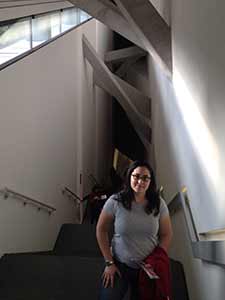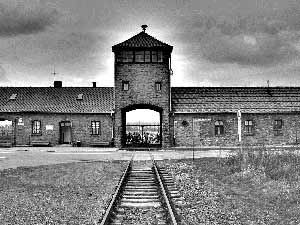Between Coercion and Resistance
In 1930s Cologne, Germany, Maximilian Samuel was a beloved obstetrician-gynecologist and decorated World War I hero. He was also Jewish.
Deported to Auschwitz in 1942 with his family, Samuel was selected to become a prisoner-physician and ordered to participate in barbaric Nazi-directed medical experiments on women. As a result, historians labeled him a “Jewish medical collaborator.”
However, Sari Siegel, a doctoral student at USC Dornsife, argues that Samuel and hundreds of other Jewish physician-prisoners in Nazi camps cannot be characterized so simply.
“I try to avoid using the term ‘collaborator’ because it has such a negative connotation,” Siegel said. “Instead I try to think of the actions of the prisoner-doctors as existing on a fluid spectrum between coercion and resistance, with those actions shifting according to a variety of factors.”
Siegel’s dissertation, which she is writing under the supervision of Wolf Gruner, Shapell-Guerin Chair in Jewish Studies, professor of history and director of the Center for Advanced Genocide Research, focuses on Jewish prisoner-physicians in Nazi camps from 1938-45 in the Greater German Reich.

Graduate student Sari Siegel visits the Libeskind Building at the Jewish Museum Berlin. Photo courtesy of Sari Siegel.
She was recently named a 2015-16 Jack, Joseph and Morton Mandel Center for Advanced Holocaust Studies Fellowship recipient for her groundbreaking research into the hitherto unexplored history of Jewish prisoner-physicians. The Center is housed at the United States Holocaust Memorial Museum. A living memorial to the Holocaust, the museum inspires citizens and leaders worldwide to confront hatred, prevent genocide and promote human dignity.
Samuel was the subject of Siegel’s case study which appeared in the Winter 2014 issue of Holocaust and Genocide Studies.
“The key to Samuel’s story is that in the absence of direct supervision it seems quite probable that — at least in a few cases — he did not follow Nazi orders but instead helped fellow inmates and minimized harm,” said Siegel, who is currently wrapping up her six-month residency as a junior fellow at the Vienna Wiesenthal Institute for Holocaust Studies in Austria.
Samuel’s wife, Hedwig, was sent to the gas chamber upon arrival, but their daughter Liese-Lotte became a prisoner in the camp. Samuel must have feared not only for the loss of his own life if he did not obey, but also that of his daughter.
Nevertheless, Siegel’s research shows that in several cases Samuel appears to have defied orders when he was not being watched. His willful subversion of certain experimental protocols, for example, likely preserved the fertility of several women who went on to have children after surviving the war.
A spectrum of adaptive behavior
Siegel adopts Holocaust survivor and writer Primo Levi’s metaphor “The Grey Zone” to describe the morally ambiguous no-man’s land in which prisoner-doctors like Samuel and other prisoner functionaries found themselves.
“I’m calling for this coercion-resistance spectrum to enhance the concept of ‘The Grey Zone,’ as the former allows us to track a prisoner-physician’s behavior from one point in time to the next and relate changes to the development of environmental factors — both immediate and more distant,” she said.
Siegel believes prisoner-physicians can act as a lens through which to view the entire history of the Holocaust.
“Because prisoner-physicians were connected to the health of inmates, their presence in the camps and the way the Nazis and industrial firms facilitated — or didn’t — their work is largely indicative of the value the Nazis and factory owners placed on Jewish life at any given time,” she said.
Prisoner-physicians aided Nazi doctors with medical experiments, but also treated inmates to the best of their abilities.

The entrance to the Auschwitz-Birkenau Nazi concentration camp.
“Their resources tended to be minimal, but at times the facilities in which they worked were surprisingly well-equipped with X-ray equipment and sterile surgical rooms,” Siegel said. “In stark contrast, others had absolutely no medication and no medical equipment. At this point, all they had to work with was their ingenuity.”
While other prisoner-functionaries, like kapos or block elders, were also seen as betraying their fellow inmates, doctors were held to a higher standard and can be perceived to have committed a “double betrayal” — of their fellow inmates and of the Hippocratic Oath.
“People have a specific and deep trust in doctors,” Siegel said. “And when that trust is violated it’s especially devastating.”
Building a legacy of insightful studies
Siegel said she was excited to receive the Mandel Center Fellowship.
“I have always considered this fellowship to be the Holy Grail for Holocaust scholars,” she said. “It offers an incredibly enriching intellectual environment, with the support of other fellows and the superb staff of the Mandel Center and the United States Holocaust Memorial Museum. That paired with nearly unparalleled archival resources make it an amazing fellowship to have.”
Siegel was one of 31 fellows chosen from 146 applicants in 34 countries.
“The fact that Sari has been given this honor pays tribute to the fine research and scholarship taking place at USC,” said Steve Klappholz, western regional director of the United States Holocaust Memorial Museum.
“Through the fellowship program we aim to train early scholars who will then serve as mentors for other up-and-coming scholars. This legacy of scholarship is illustrated by Professor Gruner, a prominent Holocaust scholar who was a Mandel Fellow early in his career and is now mentoring Sari.”
Siegel earned her bachelor’s degree in history from Yale University, where she also completed her premedical requirements. However, her love of history and the promise of her research topic pulled her away from pursuing a career in medicine and set her on a different path.
Siegel said she chose USC Dornsife principally to work with Gruner. The constantly expanding Holocaust and Genocide Studies collection in Doheny Library also played a role in her decision to attend USC. The USC Shoah Foundation was another major draw.
“Having a world renowned institute like the Shoah Foundation with its ability to bring in some of the top scholars to give talks and to have access at any time to its entire collection of testimonies through the Visual History Archive is really impressive,” she said. “It’s a resource I have tapped into on many occasions.”
Once she has earned her Ph.D., Siegel hopes to teach at the university level.
“I want to share my love of history with others,” she said.